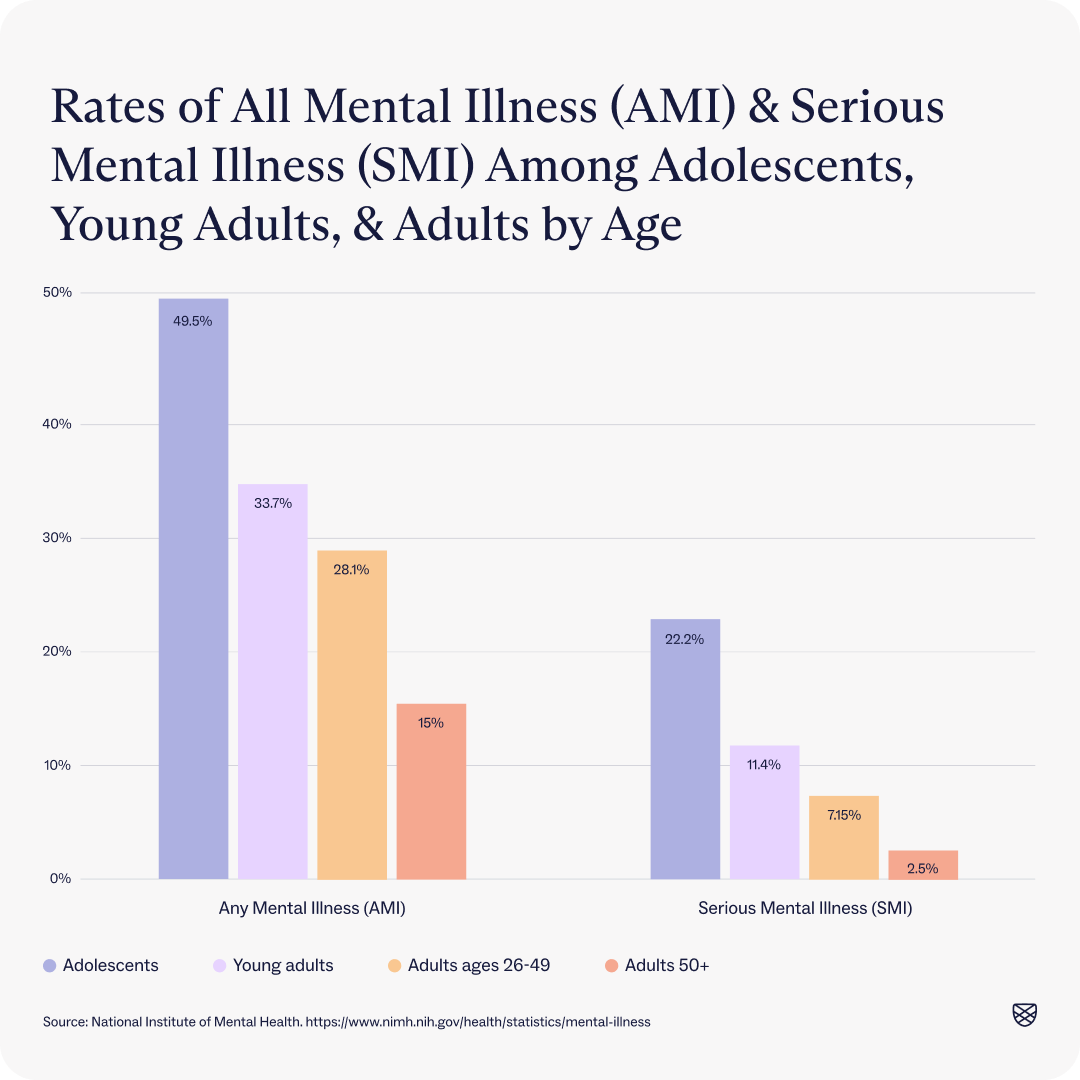5 key differences between youth and adult mental health

Rawpixel.com // Shutterstock
5 key differences between youth and adult mental health
Adult and young adult sitting on opposite sides of yellow couch, looking off into distance in front of blue wall.
Both young people and adults struggle with mental health challenges, but these experiences differ by age. Whereas young people often navigate issues with their identity, peers, and academics, adults may grapple with work-related stressors, partners or children, and life transitions. Also, many mental health conditions present with different symptoms in adolescence and adulthood, research shows.
These differences in life circumstances and developmental stages (among other factors) significantly affect youth and adult mental health needs, necessitating tailored treatment approaches for each age group. Identifying distinctions between youth and adult mental health helps ensure that people receive appropriate mental healthcare throughout their lives.
Notably, the onset of most mental health conditions is during adolescence — data shows that half of all lifetime mental health conditions begin by age 14 and three-quarters by age 24. As people age, treatment approaches must shift to meet their needs. However, transitioning from child and adolescent treatment to adult mental health services often poses challenges, with studies consistently highlighting a discontinuity of care during this process. Despite over half (50.6%) of young people aged 6 to 17 receiving mental health treatment, rates among adults are lower (47.2%), according to data collated by the National Alliance on Mental Illness (NAMI). Also, young people often experience different needs upon transitioning to adult mental health services, with as many as three-quarters (75%) receiving a new mental health diagnosis.
To assess how youth and adult mental health differ, Charlie Health looked at the numbers, including data on the prevalence of mental health conditions among adolescents, young adults, and adults, as well as the age-related effects of these conditions on daily life. Some tips on how to make the transition from youth to adult mental healthcare and how to access age-appropriate mental health services are offered as well.
Adolescents have the highest rates of mental health issues among all age groups
The National Institute of Mental Health (NIMH) surveys mental health in the United States annually using data from the Substance Abuse and Mental Health Services Administration (SAMHSA). In the 2021 survey (the most recent to date), the NIMH found that nearly half (49.5%) of adolescents between the ages of 13 and 18 had “any mental illness” (AMI) defined by researchers as a “mental, behavioral, or emotional disorder” at any degree of severity. The prevalence of AMI among adolescents is higher than among young adults (ages 18 to 25) or adults, according to the data.
Rates of severe mental health issues are also highest among adolescents
Of those adolescents with AMI, just over one-fifth (22.2%) had severe impairment or distress — roughly double the rate of “serious mental illness” (SMI) among young adults (11.4%) and more than triple the rate among adults older than 25. The NIMH defines SMI as any condition “which substantially interferes with or limits one or more major life activities.”
Young adults have higher rates of mental health issues than adults
While adolescents have the highest rates of AMI nationally, young adults deal with mental health conditions at much higher rates than adults. One-third of young adults (33.7%) had AMI — a rate more than double that of adults 50 and older (15%) and higher than adults ages 26 to 49 (28.1%), according to the NIMH. Rates of SMI were also highest among young adults (11.4%) compared to adults (7.15%) and those 50 and older (2.5%).
![]()

Charlie Health
Mental health conditions impact school performance among adolescents
Chart showing rates of mental illness by age.
Just as mental health conditions affect young people and adults at different rates, their impact varies between age groups. Among adolescents, mental health conditions significantly impact school performance.
High school students with significant symptoms of depression are more than twice as likely to drop out of school compared to their peers, according to NAMI. Also, students ages 6 to 17 with mental, emotional, or behavioral concerns are three times more likely to repeat a grade, the organization reports.
One-third of adults with a mental health condition also experience a co-occurring substance use disorder
Among adults, a significant effect of mental health challenges is substance use disorder (SUD). One-third (33.5%) of adults with a mental health condition also experienced a SUD in 2021, SAMHSA data analyzed by NAMI shows. That amounts to 19.4 million adults nationwide struggling with a mental health condition and SUD.
Depression and anxiety cause adults to lose 12 billion annual working days
Adults also face job-related effects of mental health conditions. According to data from the World Health Organization (WHO), about one in seven (15%) working-age adults lives with a mental health condition. Without proper support, these conditions can impact a person’s confidence, productivity, and attendance, leading to about 12 billion annual working days lost, according to the WHO. These lost days have a financial effect, costing the global economy $1 trillion each year, WHO data shows.
Older adults have among the highest suicide rates
While the national suicide crisis often focuses on the rising rates of suicide among adolescents and young people, older adults actually have among the highest national suicide rates. According to the Centers for Disease Control and Prevention (CDC), 20.3 per 100,000 adults aged 75 and older commit suicide annually. By contrast, the suicide rate for people ages 10 to 24 is 11 per 100,000, CDC data shows.
If you’re experiencing suicidal thoughts or are in danger of harming yourself, this is a mental health emergency. Contact The Suicide & Crisis Lifeline 24/7 by calling or texting 988.
How to find age-appropriate mental health services
As a rule of thumb, youth and adolescent mental health services are for people under 18, while adult services are for those over the age of 18. However, factors including someone’s readiness to manage their own care, severity and stability of a mental health condition, and availability of appropriate resources can influence this timeline. Below are some steps that can be taken to find age-appropriate mental health services.
Talk with a provider
If you’re on the cusp between adolescent and adult services or simply don’t know which is the right fit for you, consider asking a provider — either an existing mental health provider you’re working with or a primary care physician. These providers should be able to give you guidance about what kind of services to pursue, and may even be able to offer a referral. Also, before starting work with a new therapist, you can set up a time to talk with them and hear about their practice, which is a good time to ask about the ages they serve.
Do your research
Look for mental health providers or organizations specializing in services for your age group, starting with online databases or directories of mental health services in your area. Many websites offer filters to narrow down options based on age group and specific needs. This can include therapists, clinics, or support groups tailored to young people or adults.
Consider age-specific services
Many services outside of traditional once-weekly therapy will have a specifically stated age range they serve. Also, many therapy platforms specialize in serving specific age demographics.
This story was produced by Charlie Health and reviewed and distributed by Stacker Media.
